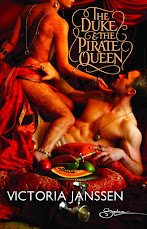It's good advice. It can remind you that it's easier for a reader to form mental pictures of characters whom they've seen in action. Action scenes are usually more compelling to read than long explanations. If a reader's interpreting actions, they're usually more involved in the story than when they're simply being told what's what. Unless the writer's voice (or the narrator's) is really compelling, showing is almost always better than telling.

But sometimes, you just have to tell.
This issue came up for me in the manuscript of The Duke and the Pirate Queen. There's a whole suspense subplot featuring two secondary characters, but its purpose isn't really to be gripping suspense. The subplot's purpose is to solve a mystery while the hero and heroine go off together and cement their relationship. (It's an erotic novel, so their relationship is the primary focus of the story.) I decided that the suspense subplot did not have to be entirely shown. I could tell.
I didn't entirely tell that subplot. I decided to show a certain amount: the investigator Sylvie's arrival at the king's court, some of her discussions with a confederate, her questioning of a stranger who had useful information (and, conveniently, provided a partner for an additional erotic scene). But the novel is not about Sylvie, and her activities for the most part don't directly affect the novel's protagonists. To show every step of her investigation might be fun and interesting, but isn't strictly necessary.
When I create an original plot outline or synopsis, I don't always know what needs to be shown and what told. I have a general idea, but some of those decisions depend on how the plot falls out while I'm writing. Therefore, I can't always decide until near the end of the draft. In this case, I decided that the outcome of Sylvie's plot was more important than the progress of it. So I took some shortcuts. I told some of what had happened offscreen (information received in a letter, for example) and then showed the results with a little action and a lot of dialogue.
There's no one right answer for when to show and when to tell. There's only the best answer you can come up with at the time, for the particular novel.
Every reader will have a different opinion on whether you were right or wrong.
Related Post:
How to Write a Novel (in 72 easy steps)!.




Yep, it can be an interesting challenge. When to tell, when to show.
ReplyDeleteI think dialogue comes in handy, given characters have a tendendy to talk like us humans do.
Definitely, I tried to make the telling more interesting through dialogue.
ReplyDelete